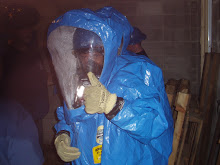More than 30 million workers are potentially exposed to one or more chemical hazards in the workplace. There are an estimated 650,000 existing hazardous chemical products, and hundreds of new ones are being introduced annually. This poses a serious problem for exposed workers and their employers. The Hazard Communication Standard (HCS) is designed to ensure that employers and employees know about hazardous chemicals in the workplace and how to protect themselves. Employers with employees who may be exposed to hazardous chemicals in the workplace must prepare and implement a written Hazard Communication Program and comply with other requirements of the standard.
All employers in addition to those in manufacturing and importing are responsible for informing and training workers about the hazards in their workplaces, retaining warning labels, and making available Material Safety Data Sheets (MSDS's) with hazardous chemicals.
All workplaces where employees are exposed to hazardous chemicals must have a written plan which describes how the standard will be implemented in that facility. The written program must reflect what employees are doing in a particular workplace. For example, the written plan must list the chemicals present at the site, indicate who is responsible for the various aspects of the program in that facility and where written materials will be made available to employees. The written program must describe how the requirements for labels and other forms of warning, material safety data sheets, and employee information and training are going to be met in the facility.
The HCS covers both physical hazards (such as flammability or the potential for explosions), and health hazards (including both acute and chronic effects). By making information available to employers and employees about these hazards, and recommended precautions for safe use, proper implementation of the HCS will result in a reduction of illnesses and injuries caused by chemicals. Employers will have the information they need to design an appropriate protective program. Employees will be better able to participate in these programs effectively when they understand the hazards involved, and to take steps to protect themselves. Together, these employer and employee actions will prevent the occurrence of adverse effects caused by the use of chemicals in the workplace.
Information adapted from OSHA Fact Sheet No. OSHA 93-26
skip to main |
skip to sidebar

Level A hands on training Exercise

Search This Blog
Hazmat Training

Level A hands on training Exercise
Safety and Health Consulting / Online Training
About Me

- Safetyguy
- Illinois, United States
- Greg is a Certified Hazardous Materials Manager, CHMM and is a 20-year veteran of the Manufacturing and Safety Professions. His background includes extensive experience ranging from industrial chemistry to engineering to plant management for a chemical manufacturer. His interest and passion for health and safety/environmental and risk analysis led him to pursue a way to share his knowledge of these fields with others. Greg holds a B.A. degree in chemistry and is a certified instructor with the Illinois Fire Service. He is also an authorized and certified outreach instructor/trainer with OSHA and a First Aid/CPR/AED instructor with the American Heart Association. He is a technician with the MABAS Division 25 Hazardous Materials Response Team and a professional member of the American Society of Safety Engineers. Greg serves his community as the Assistant Fire Chief with the Spring Valley Fire Department and as an Emergency Medical Technician – Intermediate. Since 2006, Greg has been President of All Risk Training and Safety, Inc. He teaches and consults with corporate management and safety professionals across the Midwest.

No comments:
Post a Comment